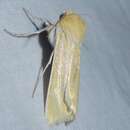Conservation Status
provided by University of Alberta Museums
A rare and very local species in Alberta.
- license
- cc-by-nc
- copyright
- University of Alberta Museums
Cyclicity
provided by University of Alberta Museums
Adults have been collected in Alberta in late July and early August.
- license
- cc-by-nc
- copyright
- University of Alberta Museums
Distribution
provided by University of Alberta Museums
Southern Alberta east to southwestern Manitoba, the eastern parts of the Dakotas and eastern Iowa; west to California and south to southern Arizona, New Mexico and western Texas. In Alberta there are historical records from Lethbridge, Monarch, High River and Calgary. The only recent records are for a colony discovered by Chris Schmidt in 2004 in dunes north of Chauvin (east of Wainwright).
- license
- cc-by-nc
- copyright
- University of Alberta Museums
General Description
provided by University of Alberta Museums
A medium-size (3.8-4.1 cm wingspan) moth with pale yellow forewings and immaculate white hindwings. Occasional specimens may have fine dark dots at the veins indicating the antemedian and postmedian lines. Copablepharon viridisparsum is white (not yellow) with a faint green cast, dark scaling in the central hindwing area and a faint dark discal spot. C. longipenne is a dull grey-brown or tan moth with light grey hindwings.
- license
- cc-by-nc
- copyright
- University of Alberta Museums
Habitat
provided by University of Alberta Museums
Sand dunes and sandy prairie.
- license
- cc-by-nc
- copyright
- University of Alberta Museums
Life Cycle
provided by University of Alberta Museums
Poorly known. The larvae overwinter buried in the soil when partly grown. They complete their development in the spring, then pupate in an earthen cell in the soil. There is a single annual brood. Adults are nocturnal and are attracted to light.
- license
- cc-by-nc
- copyright
- University of Alberta Museums
Trophic Strategy
provided by University of Alberta Museums
No data. In the lab a larvae was reared on alfalfa and barley (Strickland, 1920).
- license
- cc-by-nc
- copyright
- University of Alberta Museums
Copablepharon grandis
provided by wikipedia EN
- license
- cc-by-sa-3.0
- copyright
- Wikipedia authors and editors
Copablepharon grandis: Brief Summary
provided by wikipedia EN
Copablepharon grandis, the pale yellow dune moth, is a moth of the family Noctuidae. The species was first described by Strecker in 1878. It is found in North America from southern Alberta east to south-western Manitoba, the eastern parts of South Dakota, North Dakota and Iowa, west to California and south to southern Arizona, New Mexico and western Texas.
The wingspan is 38–41 mm. Adults are on wing from July to August depending on the location. There is one generation per year.
- license
- cc-by-sa-3.0
- copyright
- Wikipedia authors and editors

